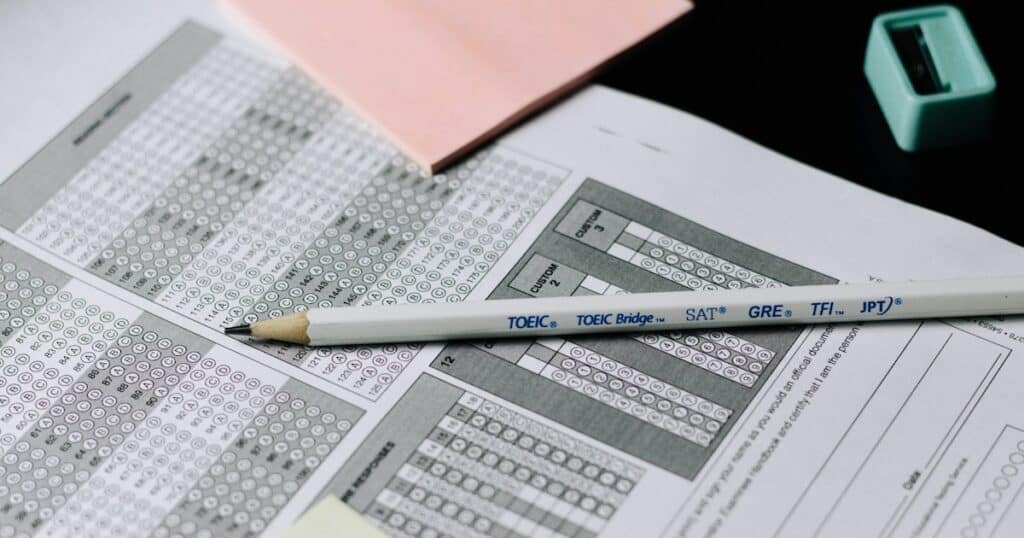Multiple Choice Test Tips

A multiple choice test always sounds easy until you’re in the exam room trying to choose between two options with no idea what the correct answer is.
There’s no one way to hack multiple choice tests, but you can take advantage of certain strategies and tips to make sure that you are as well-prepared as possible when you step to the table.
These aren’t foolproof solutions, but they can definitely help you boost your grade.
1. Answer the easy ones first
Before you start, take a quick look through the entire exam and highlight the questions you can answer most confidently, then go back and answer these questions first. This way you won’t miss out on any potential easy points.
Make sure you answer all the questions you know before attempting any guesses.
2. Keep track of time
Never spend too long answering a question. Falling behind and being crunched for time can prevent you from even getting a chance to answer all of the questions, including any easy ones that might appear toward the end.
If you are taking a long time to answer one question, it is best to just move on for the time being. You can always come back. But make sure you mark the question first.
3. Eliminate wrong answers
It’s called the process of elimination. Get rid of the answers that you know are incorrect to decrease your options and increase your likelihood to select the best answer. When none of the answers sound right, go with the option that sounds the least wrong.
4. “True” is better than “false”
William Poundstone, author of “How to Predict the Unpredictable: The Art of Outsmarting Almost Everyone,” combed through online archives of over 100 tests with answer keys in an attempt to spot trends in exams, including whether “true” or “false” appeared more frequently.
He found that “true” is, in fact, better than “false.” “True” answers appeared 56 percent of the time in comparison to 44 percent “false.”
5. When in doubt, choose B (or E)
Poundstone’s book gives us another valuable insight here. The conventional wisdom is to select (C), but his research suggested differently. It turns out that in questions with four answers (that is, with (A), (B), (C), and (D) as options), the most common answer was (B), which was correct 28 percent of the time.
On questions with five possible answers, the last answer (E) was correct most frequently, and in fact appeared six percent more frequently than the least common answer, which was the middle answer (C). (E) appeared as a correct answer 23 percent of the time over a mere 17 percent for (C).
Poundstone also noted that a “none of the above” or “all of the above” answer was very likely to be correct, being the right choice a whopping 52 percent of the time.
6. If you really don’t know, just guess
On multiple choice tests, it’s better to leave your best guess than nothing. There’s no reason to skip it and miss even a chance to get it right. If you’re unsure about your answer, you should mark the question and come back later if you have time.
7. Read the questions closely
One surefire way to miss points on an exam is to breeze through an exam skimming over the questions. Watch for potentially tricky questions with leads like “Which of the following is NOT…” or “Mark ALL answers that apply.” These kinds of questions can be easy to read incorrectly, leading to a potentially wrong answer that would otherwise be easy to avoid.
Similarly, read all of the answers listed closely so you don’t accidentally skip over the correct option.
8. Strike the outliers
Generally speaking, on questions where one answer is substantially different from the rest, there is a good chance that answer is incorrect. Looking for trends within questions can be a good way to boil your answer down to the most likely choice.
9. Study the material
At the end of the day, there are no test strategies that will lead you to the right answer 100 percent of the time. The easiest and most effective way to ensure that you are prepared for an exam is to … wait for it … prepare for the exam.
That means sitting down with your textbook and actually learning the material.
Conclusion
Multiple choice exams are a common assessment format in many educational settings, and while they can be efficient at testing a wide range of material, they often pose challenges for students. Success in multiple choice exams goes beyond simply knowing the material; it involves careful reading, strategic thinking, and leveraging test-taking techniques that can increase the likelihood of selecting the correct answers. One of the first steps to improving your chances is to thoroughly understand the question before examining the answer choices. Pay attention to key words like “always,” “never,” or “except,” as these can change the meaning of the question significantly. Misinterpreting a question, even when you know the material, can easily lead you to the wrong answer.
Once you’ve understood the question, begin by eliminating obviously incorrect answers. Often, exams with a multiple choice format include distractors—answers that are clearly irrelevant or wrong. Cross them out to narrow down your options and improve your chances of guessing correctly if needed. Another useful strategy is to look for patterns in the answer choices. For example, some exams may follow a predictable pattern where certain answers appear more frequently (e.g., many answers might be “C” or “B”). While this isn’t always a reliable strategy, it can sometimes help when you’re stuck between choices. Additionally, understanding commonly tested concepts in the subject can provide a helpful framework for making decisions about which is the correct response.
When reviewing answer choices, be cautious of options that use absolute language, such as “always” or “never,” as these are often incorrect. Real-world situations usually allow for exceptions, so answers with more moderate language (e.g., “usually,” “often,” or “sometimes”) tend to be more accurate. Furthermore, as you move through the exam, later questions might offer context that helps clarify the answers to earlier questions. Keeping track of how different questions relate to each other can sometimes provide valuable clues.
Another effective tip is to prioritize longer answer choices. While not a rule, longer answers tend to be correct more often, especially in questions where the correct response involves multiple components or a more detailed explanation. Conversely, overly short answers may be too simplistic or incomplete. However, it’s important to remember not to overthink the questions. Trust your initial instinct, particularly if you find yourself stuck between two choices. Research has shown that students often perform better when they stick with their first choice unless they’re certain it’s wrong.
In addition to these strategies, preparation plays a crucial role. Techniques such as active recall and spaced repetition can help reinforce the material and improve retention, making it easier to recall correct answers during the exam. Practicing with mock quizzes or flashcards can simulate the testing environment and help strengthen your memory of key concepts. On the day of the exam, managing your time and staying calm are also essential. Anxiety can cloud your judgment, so pacing yourself and keeping a clear head will help you approach each question more effectively. If you encounter a particularly difficult question, don’t hesitate to skip it and return to it later with a fresh perspective.
In conclusion, while there’s no surefire method to guarantee success on multiple choice exams, combining strategic approaches like eliminating wrong answers, understanding common question patterns, and preparing with active recall can significantly improve your chances. By applying these techniques, you can enhance your test-taking skills, reduce errors, and increase your overall performance.



